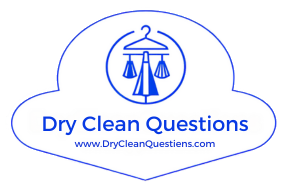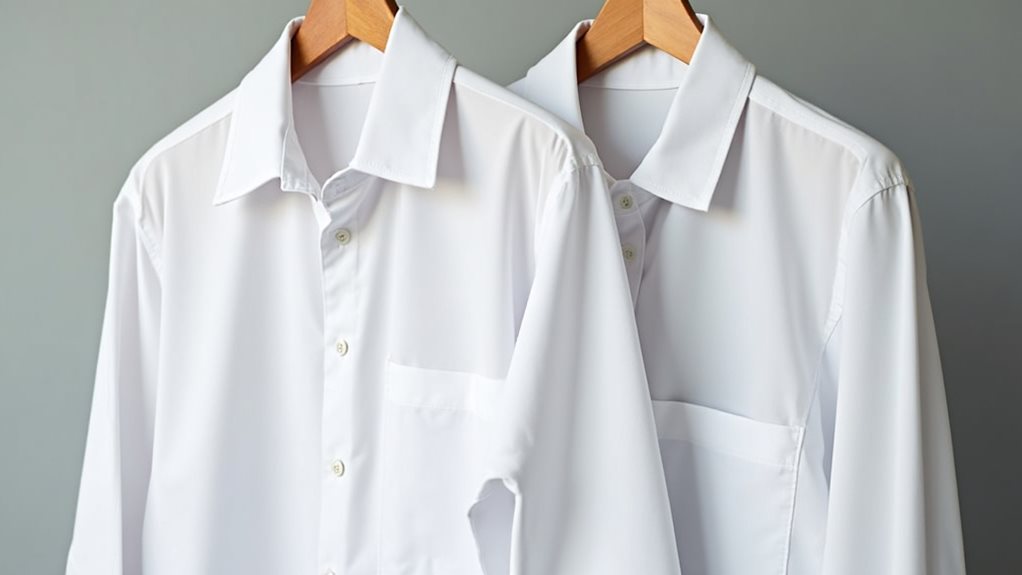You don’t always need dry cleaning, even when the label says “dry clean only” – I’ve saved hundreds by learning which items can handle gentle home washing instead. Delicate fabrics like silk and wool truly need professional care, but many cotton, linen, and polyester pieces can survive a cold, gentle cycle if you’re careful. The key lies in understanding your fabric’s resilience and doing spot tests first, because smart garment care means knowing when to splurge and when to save.
When Fabric Type Determines Dry Cleaning Requirements
While I’ve definitely learned this lesson the hard way after ruining my favorite cashmere sweater in a regular wash cycle, understanding your fabric type is honestly the most crucial factor in deciding whether you need to shell out for dry cleaning.
Delicate fabrics like silk and wool simply can’t handle the rough treatment of your washing machine, and trust me, they’ll shrink faster than your motivation on Monday morning.
Silk and wool are as fragile as your weekend plans—one wrong wash and they’ll shrink into oblivion.
Meanwhile, synthetic fabrics like polyester are basically bulletproof and can survive regular washing cycles without breaking a sweat.
High-end garments and customized items deserve the gentle touch of professional cleaning to maintain their quality, so always check that care label before making any laundry decisions.
Dry cleaning uses chemical solvents instead of water to clean these delicate materials, which prevents the damage that water-based washing typically causes to sensitive fabrics.
How Garment Structure and Embellishments Affect Cleaning Methods

Although fabric type gets most of the attention when we’re deciding between dry cleaning and home washing, the actual construction of your garment can be equally important in determining whether you’ll need professional help.
I learned this the hard way when I tossed my structured blazer into the washing machine and watched it emerge looking like a deflated balloon 😅.
Your garment structure tells its own story about cleaning methods:
- Tailored suits and formal gowns need dry cleaning to preserve their pleats, creases, and overall shape
- Intricate embellishments like embroidery and beadwork can’t survive regular washing cycles
- Care labels provide specific guidance based on construction details, not merely fabric type
These embellishments and structural elements determine how you’ll preserve your garment’s integrity over time. Items with sequins or beading require especially gentle professional care to prevent damage to these delicate decorative elements.
Understanding Care Labels and Manufacturer Guidelines
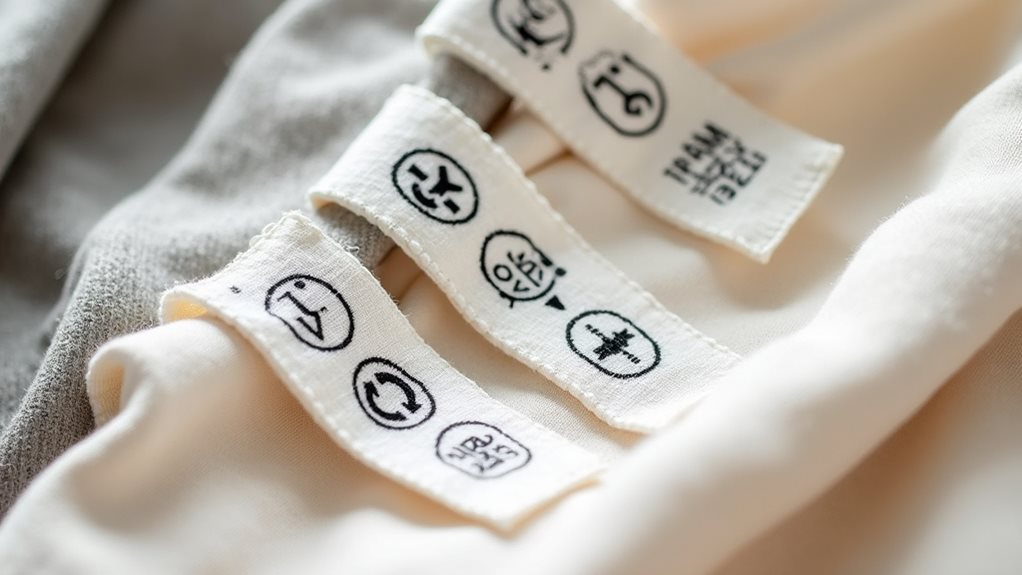
You’ll find that care labels are like tiny roadmaps sewn into your clothes, guiding you through the sometimes confusing world of fabric maintenance with symbols that might look like hieroglyphics at first glance.
When I started paying attention to these little tags instead of just cutting them out immediately (guilty as charged 😅), I discovered that “dry clean only” isn’t just a suggestion—it’s manufacturers protecting both their reputation and your investment from the heartbreak of a ruined garment.
Trust me, following those specific instructions about washing temperatures, bleach restrictions, and drying methods will save you from those “oops, I shrunk my favorite sweater” moments that we’ve all experienced at least once.
These care instructions become especially crucial when dealing with delicate fabrics like silk, wool, or cashmere that can be permanently damaged by water and traditional washing methods.
Decoding Care Label Symbols
When I first started doing my own laundry in college, those tiny symbols on clothing tags looked like ancient hieroglyphics that might as well have been written in a foreign language I’d never encountered.
You’ll discover that care label symbols are actually your clothing’s personal instruction manual, protecting delicate fabrics from laundry disasters.
These washing symbols tell you whether something’s machine washable or requires professional cleaning to maintain fabric integrity.
Here’s what you need to know:
- Washing symbols: A bucket means machine wash, while a hand indicates gentle hand washing
- Drying symbols: A circle in a square allows tumble drying, crossed out means air dry only
- Special care: “Dry clean only” symbols protect structured garments requiring professional attention
Understanding these symbols prevents those heartbreaking moments when your favorite sweater becomes doll-sized! 😅
Items with intricate beading, embellishments, or made from delicate fabrics like silk and wool particularly benefit from following these care guidelines rather than risking damage through improper cleaning methods.
Dry Clean Only Meanings
Since my wallet took quite a beating during my first year of independent adulthood, I’ll admit I used to think “Dry Clean Only” labels were just manufacturers trying to make my life more expensive and complicated.
However, these care labels actually protect delicate fabrics like silk, wool, and velvet that are sensitive to moisture and agitation from regular washing machines.
When you see “dry clean only,” it means the garment has intricate details, embellishments, or customized shapes that water could destroy, causing shrinkage, color bleeding, or structural damage.
Following these manufacturer guidelines isn’t about upselling professional dry cleaning services—it’s about prolonging lifespan and maintaining quality.
Understanding proper garment maintenance saves money long-term by keeping your favorite pieces looking fresh and well-structured.
Learning how to read care labels properly helps you identify which items truly need professional cleaning versus those that can safely be washed at home using alternative methods.
Following Manufacturer Instructions
These fabric care guidelines help you maintain the integrity of different materials through proper damage prevention techniques:
- Washable fabrics get specific temperature and cycle recommendations.
- Special care items receive detailed handling instructions beyond basic washing.
- Dry cleaning requirements protect delicate fibers from water damage.
Professional dry cleaners use specialized solvents like perchloroethylene that dissolve oils and stains without causing the structural damage that water-based washing can inflict on sensitive materials like wool and silk.
Respecting these instructions transforms garment maintenance from guesswork into science.
Items You Can Safely Wash at Home Despite Dry Clean Labels
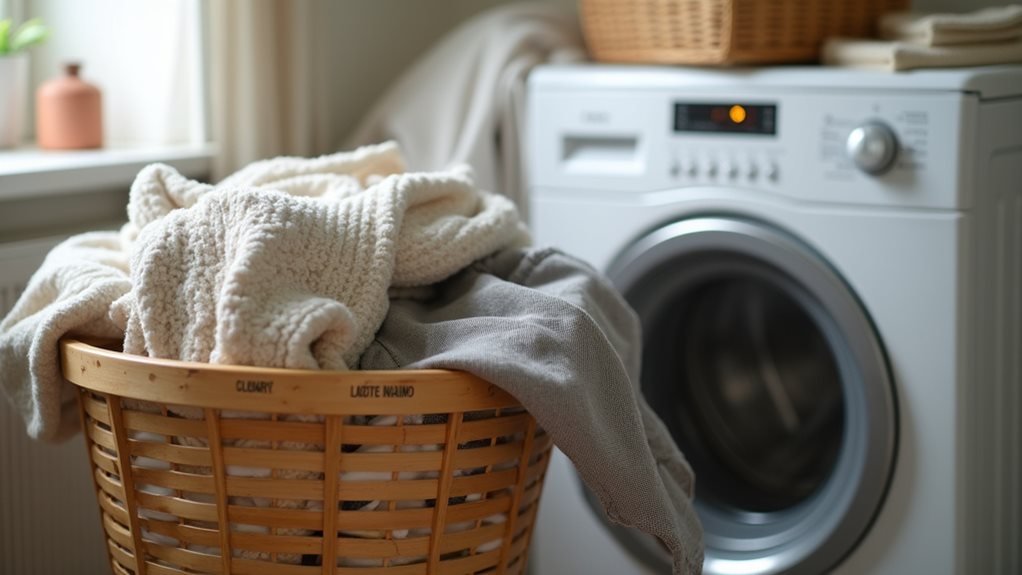
You’d be surprised how many garments in your closet that sport those intimidating “dry clean only” labels can actually handle a gentle home wash, especially if they’re made from sturdy fabrics like cotton, linen, or polyester blends that won’t throw a tantrum when they meet water.
I learned this the hard way after spending a small fortune at the cleaners for basic cotton blazers that could’ve been washed at home for pennies, which is why I now swear by doing simple spot tests on hidden seams before committing to expensive professional cleaning.
The key lies in understanding which fabrics are naturally resilient and testing their colorfastness, because once you master these basics, you’ll feel like you’ve cracked some secret code that saves both money and time 💡.
However, you should avoid attempting home washing on delicate materials like silk and wool, as well as heavily structured garments, since these are more prone to shrinkage, color bleeding, or losing their shape entirely.
Cotton and Linen Basics
When I first discovered that most of my cotton and linen pieces could be safely washed at home despite their intimidating “dry clean only” labels, I felt like I’d uncovered some sort of fashion industry secret that could save me hundreds of dollars each year.
These fabrics are surprisingly resilient, and understanding their basic care instructions can transform your laundry routine.
Here’s what you need to know:
- Turn cotton and linen garments inside out before washing to protect the surface from fading
- Use cold water in your washing machine with gentle detergent to prevent shrinking
- Air-dry these pieces instead of using heat to maintain their shape
However, cotton blends and structured garments may still require professional dry cleaning to maintain their shape and appearance over time.
The key is treating these fabrics gently while remembering they’re much tougher than their fancy labels suggest.
Polyester Blend Safety
Although polyester blends often carry those intimidating “dry clean only” tags, they’re actually some of the most forgiving fabrics you’ll encounter in your closet, and I’ve successfully washed countless pieces at home without a single disaster to report.
The secret lies in treating these hardy fabrics with gentle respect rather than expensive dry cleaning trips. Always check the care label first, but most polyester blends can be safely washed using a gentle cycle with cold water.
I recommend turning garments inside out and using a mesh bag to protect delicate details during washing. Skip the dryer drama entirely—air drying maintains their shape beautifully while preventing heat damage that could ruin your favorite pieces forever.
Unlike delicate materials such as silk and wool that truly benefit from dry cleaning’s gentler approach, polyester blends can withstand the water and agitation of traditional washing methods without losing their shape or color.
Spot Testing Methods
Why risk ruining your favorite blouse when a simple five-minute spot test can save you both heartache and money?
I’ve learned this lesson the hard way after watching a gorgeous silk scarf turn into a tie-dyed disaster 😅. Spot testing for colorfastness is your secret weapon in fabric care, helping you determine what needs professional cleaning versus what you can safely tackle at home.
Here’s my foolproof approach:
- Test hidden seams with mild detergent – if dye bleeds, skip hand washing
- Scrunch test delicate fabrics like silk to check for distortion after flattening
- Examine embellishments carefully for color bleeding and secure attachment
Smart spot testing transforms you from gambling with garments to making informed decisions, saving countless dollars on unnecessary dry cleaning bills. When you do need professional cleaning, consider choosing eco-friendly solvents over traditional dry cleaning methods to reduce exposure to potentially harmful chemicals.
Professional Stain Removal Vs Home Treatment Options
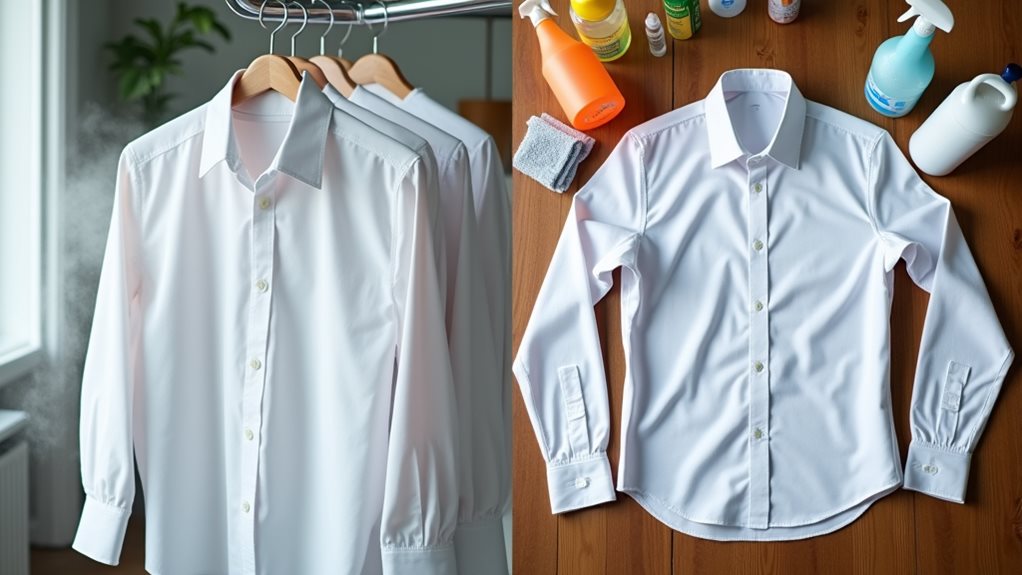
While I’ve learned this lesson the hard way through countless wardrobe mishaps, the truth is that choosing between professional stain removal and home treatment options often comes down to understanding what you’re really risking.
Trust me, I’ve turned a simple wine spill into a permanent purple badge of shame 😅.
Dry cleaners possess specialized solvents and advanced stain removal techniques that tackle stubborn stains like oil, ink, and yes, that dreaded red wine without damaging delicate fabrics.
Your home treatment arsenal, while well-intentioned, can actually set stains deeper if you’re not careful.
For high-value garments or intricate pieces, professional cleaning methods offer safer garment care, since one wrong move at home can mean saying goodbye to your favorite outfit forever.
Cost-Benefit Analysis of Dry Cleaning Vs Alternative Care Methods

When I first started tracking my clothing care expenses, the numbers made me question whether I was maintaining a wardrobe or funding someone’s vacation home 💸.
Here’s what I discovered about balancing quality care and maintenance with smart spending:
- Delicate fabrics like silk and cashmere genuinely benefit from professional dry cleaning, especially when dealing with stubborn oil-based stains that could lead to costly garment replacements.
- Cotton and polyester pieces thrive with gentle machine washing, saving you $10-30 per visit while maintaining their appearance and durability.
- Cost-effective alternatives like steaming and careful home washing work beautifully for frequently worn items, reserving dry cleaning for special occasions or high-value pieces.
The sweet spot? Reserve professional services for items where the investment truly protects long-term value.
